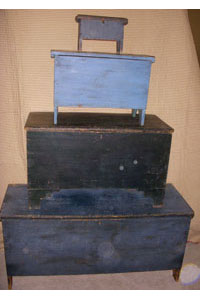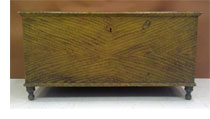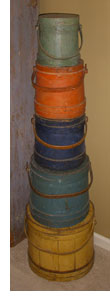|
The Blow by Blow of Blanket Boxes
 Antique blanket boxes, also known as blanket chests, come in many sizes and styles and vary widely in cost. They can be used in so many places in your home – at the traditional foot of the bed, as a side table, as a focal point for a room or as a coffee table to name just a few. A stack of boxes starting with a larger blanket box on the bottom can make for another beautiful display. In its most simple form, a blanket box is simply a large wooden box with a hinged lid. It sounds so basic, but there are many options. Antique blanket boxes, also known as blanket chests, come in many sizes and styles and vary widely in cost. They can be used in so many places in your home – at the traditional foot of the bed, as a side table, as a focal point for a room or as a coffee table to name just a few. A stack of boxes starting with a larger blanket box on the bottom can make for another beautiful display. In its most simple form, a blanket box is simply a large wooden box with a hinged lid. It sounds so basic, but there are many options.
A large blanket box can be a beautiful focal point for your room and can also store a tremendous amount. Most early blanket boxes were made out of pine or poplar. Single pine wide boards were sometimes used and you can often see they were hand planed. “Boot jack” ends refer to cut outs in the side boards which then form the legs of the blanket box allowing the box to be off the ground. Others have turned legs and some boxes sit directly on the floor.
Look for the same construction techniques in a blanket box as you find on other early furniture. Is the piece dovetailed? Are the dovetails hand-cut indicating the box is likely prior to 1870? Do the boards fit together properly and tightly? What types of hinges were used? The earliest American blanket boxes have snipe hinges or long hand-forged iron strap hinges. Are there early hand-forged wood screws or square nails? If not made from single boards, what is the construction technique to hold the multiple boards together? Is there an iron locking mechanism on the blanket box? It is hard to find a blanket box with the original key. All these are clues to the age and quality of the blanket box.
Inside the box, you may find a single or double till. This small interior box inside will often have a cover which when opened can help hold up the top of blanket box. Sometimes, a secret compartment within the till can be found. Some blanket boxes are dated and signed by the maker. Often this was done in pencil inside the box or the till, but you can also find the attribution on the back and bottom of the box as well. A blanket box signed and dated adds additional value to the piece.
 Most blanket boxes were painted. The more primitive ones were a solid color with red and blue being popular. However, many were finely painted. Grain painting, also called two-toned finish or veining, was popular from about 1820-1850. Other paint decoration, free-hand and stenciled, included smoke decoration, geometric designs and some pictorial scenes was popular, especially with the Pennsylvania Germans and up into New York state. These same techniques were being used in the south as well. Most blanket boxes were painted. The more primitive ones were a solid color with red and blue being popular. However, many were finely painted. Grain painting, also called two-toned finish or veining, was popular from about 1820-1850. Other paint decoration, free-hand and stenciled, included smoke decoration, geometric designs and some pictorial scenes was popular, especially with the Pennsylvania Germans and up into New York state. These same techniques were being used in the south as well.
Search for blanket boxes or blanket chests on Dig Antiques.
Additional Resources:
Antiques & Collectibles , 2011 Price Guide, Dan Brownell, Google books.
American Painted Furniture, Cynthia Schaffer, Clarkson Potter,1997.
American Furniture 1620 to the Present, Elizabeth Bidwell Bates and Jonathan Fairbanks,Richard Marek Publishers, 1987.
Treasure Chests: The Legacy of Extraordinary Boxes, Lon Schleining, Taunton Press, 2003.
|
|
Pack them and Stack them
Written by Guest Columnist: Lyn Andeen
 With Spring in full swing it is time to do all those household chores that we have neglected all winter. Washing windows is just about the last thing I want to do! With Spring in full swing it is time to do all those household chores that we have neglected all winter. Washing windows is just about the last thing I want to do!
 So moving on… the best way I know to start is to organize all those pesky things that I have laying around the house. I need to find some place for the winter bedding, my winter cloths, and everything that I have collected on top of bureau in my closet. So moving on… the best way I know to start is to organize all those pesky things that I have laying around the house. I need to find some place for the winter bedding, my winter cloths, and everything that I have collected on top of bureau in my closet.
A trip to The Container Store or Target for those plastic tubbies is not in my future, not when I have so many great options right at my fingertips.
For those quilts and linens I have blanket boxes strewn about the house.
The Christmas tags and ribbons can go in a stack of firkins. All those buttons I have cut off my new cloths can go into one of the pantry boxes in the master bathroom.
You get the picture.
Our forefathers knew what they were doing when they made all these things. They truly were the predecessors to modern storage.
About Lyn Andeen
Lyn Andeen has been an avid collector and dealer for the past 28 years. She has been in group shops, setup at countless antique shows and has a true artistic eye. Lyn's passion is for quality 18th through early 20th century Americana, decorative arts, Shaker and folk art. You can find Lyn online through Andeen Antiques.
|
|
Spring in the Northeast
For the first time in almost twenty years, we had the pleasure of seeing the start of spring in the Northeast. Thanks to US Airways closing the door on us when we were transferring planes in Philadelphia and not having another flight for twelve hours, we decided to drive to upstate NY instead of waiting. We started out from Philadelphia at 9am on a beautiful, sixty degree spring day. It was a lovely five hour drive to Albany and we saw mile after mile of buds and blossoms. We forgot how colorful early spring can be!
We wish you the wonder and beauty of spring renewal.
Join us on Dig Antiques and Shop and Search to you drop!
Sincerely,
Tom & Sheila Baker
diginfo@digantiques.com
We Dig It...do you? Dig Antiques - Real stuff without the fluff.

|

 Antique blanket boxes, also known as blanket chests, come in many sizes and styles and vary widely in cost. They can be used in so many places in your home – at the traditional foot of the bed, as a side table, as a focal point for a room or as a coffee table to name just a few. A stack of boxes starting with a larger blanket box on the bottom can make for another beautiful display. In its most simple form, a blanket box is simply a large wooden box with a hinged lid. It sounds so basic, but there are many options.
Antique blanket boxes, also known as blanket chests, come in many sizes and styles and vary widely in cost. They can be used in so many places in your home – at the traditional foot of the bed, as a side table, as a focal point for a room or as a coffee table to name just a few. A stack of boxes starting with a larger blanket box on the bottom can make for another beautiful display. In its most simple form, a blanket box is simply a large wooden box with a hinged lid. It sounds so basic, but there are many options. Most blanket boxes were painted. The more primitive ones were a solid color with red and blue being popular. However, many were finely painted. Grain painting, also called two-toned finish or veining, was popular from about 1820-1850. Other paint decoration, free-hand and stenciled, included smoke decoration, geometric designs and some pictorial scenes was popular, especially with the Pennsylvania Germans and up into New York state. These same techniques were being used in the south as well.
Most blanket boxes were painted. The more primitive ones were a solid color with red and blue being popular. However, many were finely painted. Grain painting, also called two-toned finish or veining, was popular from about 1820-1850. Other paint decoration, free-hand and stenciled, included smoke decoration, geometric designs and some pictorial scenes was popular, especially with the Pennsylvania Germans and up into New York state. These same techniques were being used in the south as well. With Spring in full swing it is time to do all those household chores that we have neglected all winter. Washing windows is just about the last thing I want to do!
With Spring in full swing it is time to do all those household chores that we have neglected all winter. Washing windows is just about the last thing I want to do! So moving on… the best way I know to start is to organize all those pesky things that I have laying around the house. I need to find some place for the winter bedding, my winter cloths, and everything that I have collected on top of bureau in my closet.
So moving on… the best way I know to start is to organize all those pesky things that I have laying around the house. I need to find some place for the winter bedding, my winter cloths, and everything that I have collected on top of bureau in my closet.